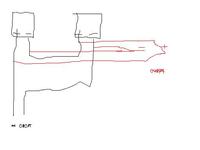gnomeman
Junior Member level 2

Hi gang, I have a question about charging 2 cell phone batteries with one wall charger.
I have 2 cell phone batteries and the wall charger that is for those batteries. I know that if I connect the 2 batteries in parallel, the charger will fully charge them in about 6 hours.
I want to use the 2 batteries connected in series to power a circuit.
With the series batteries connected to the circuit, can I run wires fron the same batteries to hook them up parallel for charging purposes only?
Will the parallel hookup interfear with the series hookup, will I need to turn off the series when the parallel is used?
quick diagram attached.
Thanks
Bill

I have 2 cell phone batteries and the wall charger that is for those batteries. I know that if I connect the 2 batteries in parallel, the charger will fully charge them in about 6 hours.
I want to use the 2 batteries connected in series to power a circuit.
With the series batteries connected to the circuit, can I run wires fron the same batteries to hook them up parallel for charging purposes only?
Will the parallel hookup interfear with the series hookup, will I need to turn off the series when the parallel is used?
quick diagram attached.
Thanks
Bill



